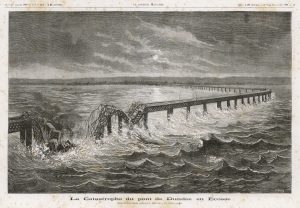Welcome to our blog series looking at the causes and consequences of well known disasters.
The Incident
The Tay Bridge disaster occurred on Sunday 28th December 1879, resulting in the
loss of life of approximately 75 people travelling on the train. Only 46 bodies were
recovered, but there were 59 known victims, 74 or 75 people were believed to be on
the train.
There was a violent storm measuring 10 to 11 on the Beaufort scale that evening,
with the wind speed measured in Glasgow at 71 mph (114 km/h). The use of the
bridge was restricted, one train at a time by a signalling block system using a baton
as a token. The train slowed to pick up the baton from the signal cabin at the south
end of the bridge then headed out on to the bridge, picking up speed.
A witness stated that he saw sparks flying from the wheels on the east side when the
train was about 200 yards (180 m) from the signalman’s cabin in the high girders.
He had seen the same thing on a previous train. The sparks continued for about
three minutes and was followed by a bright flash of light and then complete
darkness, and the train had disappeared. The train was in the river, along with high
girders and ironwork of the supporting piers.
The Causes
The Tay bridge disaster is one where the weather conditions was the prime factor.
The root cause of the accident hangs on the wind pushing the wheel flanges into
contact with the running rails causing disintegration of the cast wheels causing
derailment and the collapse of the iron girders.
The Changes
Today all such structures would be formed in steel. A much stronger material and
research made into the most serious wind forces in that area for a number of years
and used in the structure calculations.
Equally the same for the flanged wheels.
More considerations are given to weather conditions and the safety of rail travel.
The Lessons
Weather conditions is a variable that can affect many occupations and should be
considered as part of health and safety risk assessments.
This may include building structures to withstand severe weather conditions and
working during such conditions.
As conditions can change quickly, it relies on all those who could be harmed
remaining vigilant and understanding what to do when things take a turn for the
worse.
Like the witness in this case, employees, customers or the public may identify early
warning signs of potentially leathal risks. It’s important to have a clear route of
communication for these parties to reach those in the organisation who are able to
make discussions of safty controls.
Conclusion
The blog was written by Peter Clements MA; MSc; Dip Eng; Dip SM. Peter’s career
has spanned motor manufacture, aerospace and engineering.
Assent Risk Management supports organisations in these industries and more to
manage occupational health and safety risks.
Find out more about our health and safety consultancy services and ISO 45001 the
international standard for occupational health and safety.


